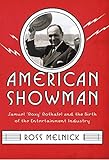American Showman : Samuel "Roxy" Rothafel and the Birth of the Entertainment Industry, 1908-1935 / Ross Melnick.
Material type: TextSeries: Film and Culture SeriesPublisher: New York, NY : Columbia University Press, [2012]Copyright date: ©2012Description: 1 online resource (576 p.) : ‹B›27 black-and-white photos‹/B›Content type:
TextSeries: Film and Culture SeriesPublisher: New York, NY : Columbia University Press, [2012]Copyright date: ©2012Description: 1 online resource (576 p.) : ‹B›27 black-and-white photos‹/B›Content type: - 9780231159050
- 9780231504256
- 809 21
- PS2502 .B43 2000
- online - DeGruyter
- Issued also in print.
| Item type | Current library | Call number | URL | Status | Notes | Barcode | |
|---|---|---|---|---|---|---|---|
 eBook
eBook
|
Biblioteca "Angelicum" Pont. Univ. S.Tommaso d'Aquino Nuvola online | online - DeGruyter (Browse shelf(Opens below)) | Online access | Not for loan (Accesso limitato) | Accesso per gli utenti autorizzati / Access for authorized users | (dgr)9780231504256 |
Browsing Biblioteca "Angelicum" Pont. Univ. S.Tommaso d'Aquino shelves, Shelving location: Nuvola online Close shelf browser (Hides shelf browser)

|

|

|

|

|

|

|
||
| online - DeGruyter Rushed to Judgment : Talk Radio, Persuasion, and American Political Behavior / | online - DeGruyter Atlas : The Archaeology of an Imaginary City / | online - DeGruyter Burma Redux : Global Justice and the Quest for Political Reform in Myanmar / | online - DeGruyter American Showman : Samuel "Roxy" Rothafel and the Birth of the Entertainment Industry, 1908-1935 / | online - DeGruyter The Compromise of Liberal Environmentalism / | online - DeGruyter Mistress and Maid (Jiohong ji) by Meng Chengshun. | online - DeGruyter The Economists' Voice 2.0 : The Financial Crisis, Health Care Reform, and More / |
Frontmatter -- Contents -- List of Illustrations -- Acknowledgments -- Introduction -- PART ONE. ROXY AND SILENT FILM EXHIBITION -- 1. A New Art for a New Art Form (1908-1913) -- 2. Broadway Melody (1913-1917) -- 3. The Movie House as Recruiting Center (1917-1918) -- 4. "The Man Who Gave the Movies a College Education" (1919-1922) -- PART TWO. ROXY AND THE EMERGENCE OF CONVERGENCE -- 5. A Capitol Idea (1922-1925) -- 6. "It's the Roxy and I'm Roxy" (1925-1927) -- 7. It's All Playing in Sheboygan (1928-1931) -- 8. The Prologue Is Past (1931-1936) -- Afterword -- Notes -- Bibliography -- Index -- Film and Culture
restricted access online access with authorization star
http://purl.org/coar/access_right/c_16ec
Samuel "Roxy" Rothafel (1882-1936) built an influential and prolific career as film exhibitor, stage producer, radio broadcaster, musical arranger, theater manager, war propagandist, and international celebrity. He helped engineer the integration of film, music, and live performance in silent film exhibition; scored early Fox Movietone films such as Sunrise (1927); pioneered the convergence of film, broadcasting, and music publishing and recording in the 1920s; and helped movies and moviegoing become the dominant form of mass entertainment between the world wars. The first book devoted to Rothafel's multifaceted career, American Showman examines his role as the key purveyor of a new film exhibition aesthetic that appropriated legitimate theater, opera, ballet, and classical music to attract multi-class audiences. Roxy scored motion pictures, produced enormous stage shows, managed many of New York's most important movie houses, directed and/or edited propaganda films for the American war effort, produced short and feature-length films, exhibited foreign, documentary, independent, and avant-garde motion pictures, and expanded the conception of mainstream, commercial cinema. He was also one of the chief creators of the radio variety program, pioneering radio broadcasting, promotions, and tours.The producers and promoters of distinct themes and styles, showmen like Roxy profoundly remade the moviegoing experience, turning the deluxe motion picture theater into a venue for exhibiting and producing live and recorded entertainment. Roxy's interest in media convergence also reflects a larger moment in which the entertainment industry began to create brands and franchises, exploit them through content release "events," and give rise to feature films, soundtracks, broadcasts, live performances, and related consumer products. Regularly cited as one of the twelve most important figures in the film and radio industries, Roxy was instrumental to the development of film exhibition and commercial broadcasting, musical accompaniment, and a new, convergent entertainment industry.
Issued also in print.
Mode of access: Internet via World Wide Web.
In English.
Description based on online resource; title from PDF title page (publisher's Web site, viewed 02. Mrz 2022)


